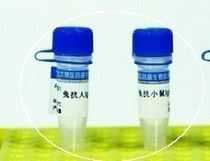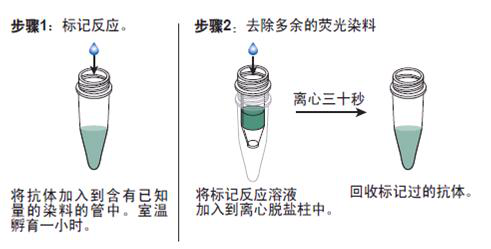
|

| 产地 | 进口、国产 |
| 品牌 | 上海莼试 |
| 保存条件 | Store at -20 °C |
| 货号 | CS10828 |
| 应用范围 | WB=1:100-500 ELISA=1:500-1000 IP=1:20-100 IHC-P=1:100-500 IHC-F=1:100-500 ICC=1:100-500 IF=1:100-500 |
| CAS编号 | |
| 抗体名 | Anti-phospho-PRKCZ(Thr410) |
| 克隆性 | |
| 靶点 | 详见说明书 |
| 适应物种 | 详见说明书 |
| 形态 | 详见说明书 |
| 宿主 | 详见说明书 |
| 亚型 | IgG |
| 标识物 | 详见说明书 |
| 浓度 | 1mg/1ml% |
| 免疫原 | KLH conjugated Synthesised phosphopeptide derived from human PRKCZ around the phosphorylation site of Thr410 |
抗体的生物素化标记实验要点:
1. 磷酸化蛋白激酶C(T410)抗体说明书 如在反应混合液中有叠氮钠或游离氨基存在,会抑制标记反应。因此,蛋白质在反应前要对 0.1mol/L碳酸氢钠缓冲液或0.5mol/L硼酸缓冲液充分透析;
2.所用的NHSB及待生物素化蛋白质之间的分子比按蛋白质表面的ε-氨基的密度会有所不同,选择不当则影响标记的效率,应先用几个不同的分子比来筛选最适条件;
3.用NHSB量过量也是不利的,抗原的结合位点可能因此被封闭,导致抗体失活;
4.由于抗体的氨基不易接近可能造成生物素化不足,此时可加入去污剂如 Triton x-100, Tween20等;
5.当游离ε-氨基(赖氨酸残基的氨基)存在于抗体的抗原结合位点时,或位于酶的催化位点时,生物素化会降低或损伤抗体蛋白的结合力或活性;
6.生物素还可能与不同的功能基团,如羰基、氨基、巯基、异咪唑基及*基,也可与糖基共价结合;
7.交联反应后,应充分透析,否则,残余的生物素会对生物素化抗体与亲和素的结合产生竞争作用;
8.在细胞的荧光标记实验中,中和亲和素的本底低,但由于链霉亲和素含有少量正电荷,故对某些细胞可导致高本底。
产品订购信息:
英文名称 Anti-phospho-PRKCZ(Thr410)
中文名称 磷酸化蛋白激酶C(T410)抗体说明书
别 名 PRKCZ(phospho T410); PRKCZ(phospho Thr410); p-PRKCZ(T410); rotein Kinase C; AAG6; Aging associated gene 6; MGC129900; MGC129901; MGC41878; MGC57564; PKC B; PKC beta; PKC zeta; PKC2; PKCB; PKCC; PKCD; PKCE; PKCG; PRKACA; PRKC A; PRKC G; PRKCA; PRKCB; PRKCB1; PRKCB2; PRKCD; PRKCE; PRKCG; PRKCZ ; Protein kinase C alpha; Protein kinase C alpha type; Protein Kinase C; Protein kinase C beta 1; Protein kinase C beta 1 polypeptide; Protein kinase C beta; Protein kinase C beta type; Protein kinase C delta; Protein kinase C epsilon; Protein kinase C gamma; Protein kinase C gamma type; Protein kinase C zeta; SCA14; Spinocerebellar ataxia 14.


浓 度 1mg/1ml
规 格 0.1ml/100μg
抗体来源 Rabbit
克隆类型 polyclonal
交叉反应 Human, Mouse, Rat, Dog, Pig, Cow, Horse, Rabbit
产品类型 一抗 磷酸化抗体
研究领域 免疫学 神经生物学 信号转导 转录调节因子 激酶和磷酸酶
蛋白分子量 predicted molecular weight: 66kDa
性 状 Lyophilized or Liquid
免 疫 原 KLH conjugated Synthesised phosphopeptide derived from human PRKCZ around the phosphorylation site of Thr410
亚 型 IgG
纯化方法 affinity purified by Protein A
储 存 液 0.01M PBS, pH 7.4 with 10 mg/ml BSA and 0.1% Sodium azide
磷酸化蛋白激酶C(T410)抗体说明书 产品应用 WB=1:100-500 ELISA=1:500-1000 IP=1:20-100 IHC-P=1:100-500 IHC-F=1:100-500 ICC=1:100-500 IF=1:100-500
(石蜡切片需做抗原修复)
not yet tested in other applications.
optimal dilutions/concentrations should be determined by the end user.
保存条件 Store at -20 °C for one year. Avoid repeated freeze/thaw cycles. The lyophilized antibody is stable at room temperature for at least one month and for greater than a year when kept at -20°C. When reconstituted in sterile pH 7.4 0.01M PBS or diluent of antibody the antibody is stable for at least two weeks at 2-4 °C.
Important Note This product as supplied is intended for research use only, not for use in human, therapeutic or diagnostic applications.
产品介绍 Protein kinase C (PKC) zeta is a member of the PKC family of serine/threonine kinases which are involved in a variety of cellular processes such as proliferation, differentiation and secretion. Unlike the classical PKC isoenzymes which are calcium-dependent, PKC zeta exhibits a kinase activity which is independent of calcium and diacylglycerol but not of phosphatidylserine. Furthermore, it is insensitive to typical PKC inhibitors and cannot be activated by phorbol ester. Unlike the classical PKC isoenzymes, it has only a single zinc finger module. These structural and biochemical properties indicate that the zeta subspecies is related to, but distinct from other isoenzymes of PKC. Alternative splicing results in multiple transcript variants encoding different isoforms. [provided by RefSeq, Jul 2008].
Function : Calcium- and diacylglycerol-independent serine/threonine-protein kinase that functions in phosphatidylinositol 3-kinase (PI3K) pathway and mitogen-activated protein (MAP) kinase cascade, and is involved in NF-kappa-B activation, mitogenic signaling, cell proliferation, cell polarity, inflammatory response and maintenance of long-term potentiation (LTP). Upon lipopolysaccharide (LPS) treatment in macrophages, or following mitogenic stimuli, functions downstream of PI3K to activate MAP2K1/MEK1-MAPK1/ERK2 signaling cascade independently of RAF1 activation. Required for insulin-dependent activation of AKT3, but may function as an adapter rather than a direct activator. Upon insulin treatment may act as a downstream effector of PI3K and contribute to the activation of translocation of the glucose transporter SLC2A4/GLUT4 and subsequent glucose transport in adipocytes. In EGF-induced cells, binds and activates MAP2K5/MEK5-MAPK7/ERK5 independently of its kinase activity and can activate JUN promoter through MEF2C. Through binding with SQSTM1/p62, functions in interleukin-1 signaling and activation of NF-kappa-B with the specific adapters RIPK1 and TRAF6. Participates in TNF-dependent transactivation of NF-kappa-B by phosphorylating and activating IKBKB kinase, which in turn leads to the degradation of NF-kappa-B inhibitors. In migrating astrocytes, forms a cytoplasmic complex with PARD6A and is recruited by CDC42 to function in the establishment of cell polarity along with the microtubule motor and dynein. In association with FEZ1, stimulates neuronal differentiation in PC12 cells. In inflammatory response, is required for the T-helper 2 (Th2) differentiation process, including interleukins production, efficient activation of JAK1 and the subsequent phosphorylation and nuclear translocation of STAT6. May be involved in development of allergic airway inflammation (asthma), a process dependent on Th2 immune response. In NF-kappa-B-mediated inflammatory response, can relieve the SETD6-dependent repression of NF-kappa-B target genes by phosphorylating the RELA subunit at 'Ser-311'. Is necessary and sufficient for LTP maintenance in hippocampal CA1 pyramidal cells.
Subunit : Forms a ternary complex with SQSTM1 and KCNAB2. Forms another ternary complex with SQSTM1 and GABRR3. Forms a complex with SQSTM1 and MAP2K5 (By similarity). Interacts with PARD6A, PARD6B, PARD6G and SQSTM1. Part of a complex with PARD3, PARD6A or PARD6B or PARD6G and CDC42 or RAC1. Interacts with ADAP1/CENTA1. Forms a ternary complex composed of SQSTM1 and PAWR. Interacts directly with SQSTM1 (Probable). Interacts with IKBKB. Interacts (via the protein kinase domain) with WWC1. Forms a tripartite complex with WWC1 and DDR1, but predominantly in the absence of collagen. Component of the Par polarity complex, composed of at least phosphorylated PRKCZ, PARD3 and TIAM1. Interacts with PDPK1 (via N-terminus region).
Subcellular Location : Cytoplasm. Endosome. Cell junction. Note=In the retina, localizes in the terminals of the rod bipolar cells. Associates with endosomes. Presence of KRIT1, CDH5 and RAP1B is required for its localization to the cell junction.
Post-translational modifications : CDH5 is required for its phosphorylation at Thr-410. Phosphorylated by protein kinase PDPK1; phosphorylation is inhibited by the apoptotic C-terminus cleavage product of PKN2. Phosphorylation at Thr-410 by PI3K activates the kinase.
Similarity : Belongs to the protein kinase superfamily. AGC Ser/Thr protein kinase family. PKC subfamily.
Contains 1 AGC-kinase C-terminal domain.
Contains 1 OPR domain.
Contains 1 phorbol-ester/DAG-type zinc finger.
Contains 1 protein kinase domain.
Database links : UniProtKB/Swiss-Prot: Q05513.4

抗体的鉴定:
1)磷酸化蛋白激酶C(T410)抗体说明书 抗体的效价鉴定:不管是用于诊断还是用于,制备抗体的目的都是要求较高效价。不同的抗原制备的抗体,要求的效价不一。鉴定效价的方法很多,包括有试管凝集反应,琼脂扩散试验,酶联免疫吸附试验等。常用的抗原所制备的抗体一般都有约成的鉴定效价的方法,以资比较。如制备抗抗体的效价,一般就采用琼脂扩散试验来鉴定。
2)抗体的特异性鉴定:抗体的特异性是指与相应抗原或近似抗原物质的识别能力。抗体的特异性高,它的识别能力就强。衡量特异性通常以交叉反应率来表示。交叉反应率可用竞争抑制试验测定。以不同浓度抗原和近似抗原分别做竞争抑制曲线,计算各自的结合率,求出各自在IC50时的浓度,并按公式计算交叉反应率。
如果所用抗原浓度IC50浓度为pg/管,而一些近似抗原物质的IC50浓度几乎是无穷大时,表示这一抗血清与其他抗原物质的交叉反应率近似为0,即该血清的特异性较好。
3)抗体亲和力:是指抗体和抗原结合的牢固程度。亲和力的高低是由抗原分子的大小,抗体分子的结合位点与抗原决定簇之间立体构型的合适度决定的。有助于维持抗原抗体复合物稳定的分子间力有氢键,疏水键,侧链相反电荷基因的库仑力,范德华力和空间斥力。亲和力常以亲和常数K表示,K的单位是L/mol。抗体亲和力的测定对抗体的筛选,确定抗体的用途,验证抗体的均一性等均有重要意义。

Anti-Apollon/FITC 荧光素标记Apollon凋亡抑制蛋白抗体IgGMulti-class antibodies规格: 0.2ml
Anti-Phospho-FHIT (Tyr114) /FITC 荧光素标记抗磷酸化脆性组氨酸三联体抗体IgGMulti-class antibodies规格: 0.2ml
Rhesus antibody Rh Collagen IV 抗IV型胶原抗体 规格 0.1ml
SPAG5/map126 相关抗原5(多肽抗原) 0.5mg
phospho-JMJD2B(Thr305) 英文名称: 磷酸化组蛋白去甲基化酶JMJD2B抗体 0.1ml
Rhesus antibody Rh TTC3/RNF105 环指蛋白105抗体 规格 0.2ml
Anti-Phospho-FHIT (Tyr114) /FITC 荧光素标记抗磷酸化脆性组氨酸三联体抗体IgGMulti-class antibodies规格: 0.2ml
Anti- Beta-lactoglobulin/FITC 荧光素标记β-乳球蛋白抗体IgGMulti-class antibodies规格: 0.2ml
Anti-SNAP-25 /FITC 荧光素标记突触相关蛋白25抗体IgGMulti-class antibodies规格: 0.2ml
Rhesus antibody Rh AKT/PKB 蛋白激酶B 规格 0.1ml
Rabbit Anti-horse IgG/PE-CY5 PE-CY5标记的兔抗马IgG 0.1ml
Gab1 英文名称: 接头蛋白Gab 1抗体 0.1ml
Rhesus antibody Rh Rabbit Anti-Guinea pig IgG/Alexa Fluor 350 Alexa Fluor 350标记的兔抗豚鼠IgG 规格 0.1ml
Anti-SNAP-25 /FITC 荧光素标记突触相关蛋白25抗体IgGMulti-class antibodies规格: 0.2ml
PIIINP 大鼠III型前胶原肽(N端)Multi-class antibodies规格: 48T
Anti-DKK1 蛋白DKK1抗体Multi-class antibodies规格: 0.2ml
Rhesus antibody Rh NDE1 核分布基因E同源蛋白1抗体 规格 0.2ml
Human apoprotein A1,apo-A1 ELISA Kit 人载脂蛋白A1 96T
SLC1A5 英文名称: 溶质携带物家族-1抗体 0.2ml
CRF 英文名称: 促肾上腺皮质激素释放因子抗体 0.1ml
Anti-DKK1 蛋白DKK1抗体Multi-class antibodies规格: 0.2ml
GlucoseAsparagineMedium
DMEM(低糖),干粉 "含1000mg/l葡萄糖,L-谷氨酰胺, incubation media DMEM(低糖),干粉 "含1000mg/l葡萄糖,L-谷氨酰胺,
酵米面假单胞菌(酵米面黄杆菌) 支/瓶
CIN-(9cm)用于分离小肠耶尔森氏菌
RVSalmonellaEnrichmentMedium
抗生素检定培养基H)(05药典)250g用于磺苄青霉素效价测定
马铃薯琼脂 100(g) incubation media 马铃薯琼脂 100(g)
磷酸盐葡萄糖蛋白胨水培养基 Phosphate Glucose Peptone Water 250克 用于甲基红试验
菌种培养基250用于四环素检定中蜡样芽孢杆菌的培养(SN标准)incubationmedia菌种培养基250用于四环素检定中蜡样芽孢杆菌的培养(SN标准)
我妻氏培养基基础 250g 用于副溶血性弧菌神奈川现象试验(GB标准、SN)
磷酸化蛋白激酶C(T410)抗体说明书 亮绿乳糖液体培养基(BGB) 规格: 250g 用途: 用于多管发酵法测定饮用矿泉水中大肠菌群的确证试验(GB/T8538-2008)。
品红亚培养基(远藤琼脂培养基) 规格: 250g 用途: 用于水中大肠菌群的分离或确证试验。 (GB/T8538-2008和GB5750.12—2006)。
乳糖胆盐发酵培养基 规格: 250g 用途: 用于多管发酵法测定食品、药品、纯净水、矿泉水和一次性使用卫生用品中大肠菌群、粪大肠菌群和大...
大肠菌群显色培养基 规格: 1000ml 用途: 用于大肠菌群的快速检测和计数。